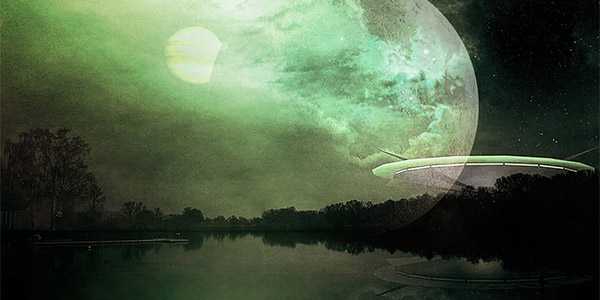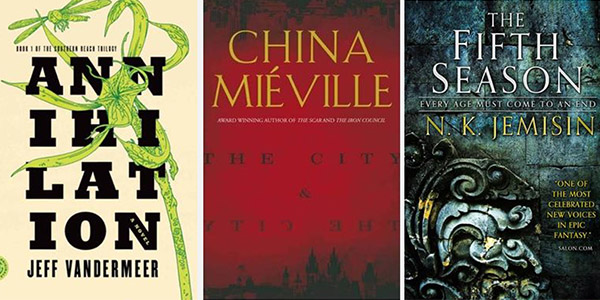CLASS PROFILE
Inhabiting Science Fiction
Students in 21L.434/"21st Century Science Fiction" discover that the world-building of science fiction is not only a way to envision possible futures, but a powerful way to think about the world we currently inhabit.

Detail: "Amesthyst"; courtesy of the artist, Manzel Bowman
“I was immediately drawn to the opportunity to discuss issues of race, gender, and colonialism through a range of speculative fiction. Professor Finch framed the genre in a way that really spoke to a whole range of social justice issues that we are attempting to navigate today.”
— Meriam Soltan, Masters student, Architecture Studies
In March this year, literary heavyweights Kazuo Ishiguro and Neil Gaiman — Nobel Laureate and beloved author of American Gods, Sandman, and Good Omens respectively — convened at an independent bookstore event to discuss genre and science fiction.
They arrived at twin conclusions: one, that rigid genre distinctions between literary works promotes an unproductive and false hierarchy of worth, and two, that the twenty-first century is a very tricky time to attempt to define “science fiction” at all. Gaiman said that he increasingly feels genre “slippage where science fiction is concerned” because, he says, “the world has become science fiction.” The hacking exploits in William Gibson’s novel Neuromancer or the sequencing of an entire genome overnight no longer belong to the realm of fantasy.
For MIT students the permeable relationship between reality and science fiction is often familiar territory. In their labs and research projects, students and faculty experience personally the process by which imaginative ideas turn into new techniques, possibilities, medicines, tools, and technologies. (And they learn that many such new realities actually have had their origins in speculative literature.)
Students in the MIT Literature course 21st Century Science Fiction (21L.434), taught by Assistant Professor Laura Finch, also discover that science fiction is a powerful, useful way to think about and understand the world we currently inhabit. The course, which deals with the imaginative flexibility and speculative potential in science fiction and fantasy, is explores how we could inhabit worlds seen through lenses of sci-fi books such as N.K. Jemison’s The Fifth Season, Jeff VanderMeer’s Annihilation, and China Miéville’s The City & The City — all books explored in the class.

21L.434 helps MIT students develop a set of fundamental skills that serve problem-solvers well in every field. And it does so with "a hopeful, imaginative bent, sharing works that ask, even in times of crisis and uncertainty: what can flourish?"
Seeing the world in new ways
Arriving at MIT, Finch knew contemporary science fiction would be natural fit for the MIT education — which combines perspectives across a wide range of science, technology, humanities, arts, and social science fields. “All literature classes are about seeing the world a different way,” Finch says, “whether it’s Shakespeare or Milton or realist novels.” The 21st Century Science Fiction course explores a range of worldviews that are free of conventional boundaries. As students consider seemingly fantastical stories, they rise to the challenge of recognizing characteristics, problems, and potentials that exist in their own societies.
“I was immediately drawn to the opportunity to discuss issues of race, gender, and colonialism through a range of speculative fiction,” said Meriam Soltan, a masters student in Architecture Studies, recalling what attracted her to the class. “Right from the start, Professor Finch framed the genre in a way that really spoke to a whole range of social justice issues that we are attempting to navigate today.”
The course has an explicit social justice bent to it: rather than space operas or extreme-tech science fiction, the focus is on authors who rethink the contemporary moment and its various perils, uncertainties, and injustices; authors who use a future space to reimagine potentials for the present.
“Sci-fi enables us to world-build a more just world, outside of the constraints of what is ‘feasible’ in our current political constraints. As an engineer who will probably help shape our world in the next decades of the climate crisis, it feels vital that I world-build with others, hearing each other’s thoughts and dreaming of a better system together.”
— Jocelyn Ting, Materials Science & Engineering, Electrical Engineering
The inspiration for the course grew out of Finch’s sense that a cultural atmosphere of despair and turmoil — especially in American politics — was weighing on college students. She thought that the unbounded imagination and fresh avenues of science fiction would enable students to better see that “the present reality is not here forever — and that we have the power to change things.”
Especially in the face of the pandemic, keystone books like The Fifth Season give necessary reminders of possibility and resistance, of human and beyond-human nature working in a subtle alliance for positive change. “This isn’t about utopia,” Finch says. “It’s about pushing back in solidarity against a historical, overarching oppressive power.”
“Sci-fi enables us to world-build a more just world, outside of the constraints of what is ‘feasible’ in our current political constraints,” says Jocelyn Ting, a Materials Science and Engineering with Electrical Engineering major. “As an engineer who will probably help shape our world in the next decades of the climate crisis, it feels vital that I world-build with others, hearing each other’s thoughts and dreaming of a better system together.”
Beyond the human
Works in the genre of Indigenous Futurisms are specifically pushing back against the settler colonial narrative that Indigenous people belong to the past, and that if an Indigenous person behaves in "contemporary" or "modern" ways they are no longer (so goes the white settler culture critque) being "authentically" Indigenous. Against that background, Indigenous Futurism is a way for Indigenous writers, artists, and musicians to counter such violent historicizing. “Welcome to Your Authentic Indian Experience™” by Rebecca Roanhorse opens the course with the question of who gets to shape and share cultural histories, and who gets to consume them — through the lens of futuristic virtual technology in an otherwise realistic world.
The City & The City, for instance, tells the noirish detective story in a city that shares the same space with another, separate city. Each minute of each day, the citizens of one city have to consciously unsee the denizens of the other, ignoring smells and sounds that no societal taboos or boundaries can prevent, as each city continues on in its own distinct habits and cultures. It is deeply prohibited to acknowledge the other city or its people, a measure enforced by a terrifying and omnipresent police force called Breach.
The conceit may seem fantastic, until the reader begins to do the difficult work of parsing how this is already the reality in the United States. Experimental architect Olalekan Jeyifous reflects on his own understanding of The City & The City in one class reading, especially in regards to gentrification: “Walking up and down the street every day, I see such a complete disconnect between the two communities of the Black folks sitting on the steps chilling and then newer gentrifying folks spilling out of bars. They may walk into the same bodega, but there’s zero acknowledgment.”

Covers for: Annihilation, by Jeff Vandermeer; The City & The City, by China Miéville; The Fifth Season, by N.K. Jemisin
"In the unit focused on Jeff VanderMeer’s novel Annihilation, students look 'beyond the human' to ask how eco-critical narratives push back against continual, capitalistic growth and work to account for the messy and natural processes of our planet. That reading is couched in dense, rich sentences, and as they read, the students hone their skills in deciphering those intricacies."
Soltan reflects that the critical class discussions relate to her own research in architecture, as the course grapples with “liberating” discussions of urban form, space, and planning. “I’m always interested in how fictions are formalized into the built environment,” she says. “I think the class material and discussions really help reclaim that process. We’re introduced to a whole toolkit of methods that might expand our thinking and make space for other possible futures.”
Such coded, reframed analyses open up fresh perspectives. For instance, in the unit focused on Jeff VanderMeer’s Annihilation, students look “beyond the human” to ask how eco-critical narratives push back against continual, capitalistic growth and work to account for the messy and natural processes of our planet. That reading is couched in dense, rich sentences in the fairly short novel — and as they read, the students hone their skills in deciphering those intricacies.
“I really want students to come out of this class knowing how to do close reading,” says Finch, “because that’s a skill in life that’s so translatable and important — in everything from political discourse and rhetoric to thinking about your relationship to your own mind.”
The course helps students develop fundamental literary skills — from close reading to essay writing to imaginative world-building — all of which serve problem-solvers well. And it does so with a hopeful, imaginative bent, sharing works that ask, even in times of crisis and uncertainty: what can flourish?
Suggested links
Course listing: 21st Century Science Fiction - 21L.434
Interview: 3Q with MIT Professor Sandy Alexandre: On the literary roots of tech innovations
Story: Alexandre receives 2019 Bose Research Grant for science fiction and technology project
Story prepared by MIT SHASS Communications
Editor and Designer: Emily Hiestand, Communications Director
Staff Writer: Alison Lanier, Senior Communications Associate
Published 29 April 2021